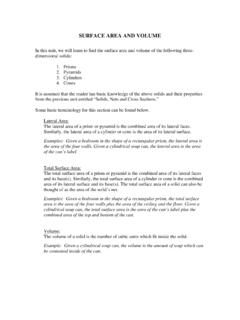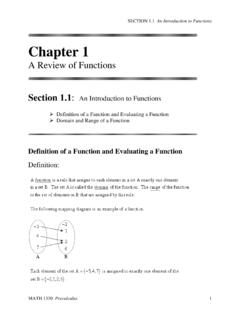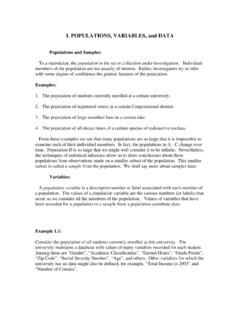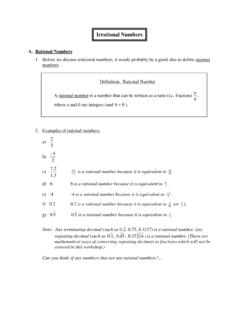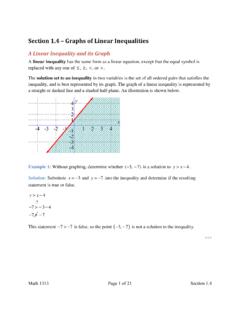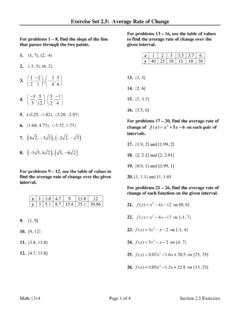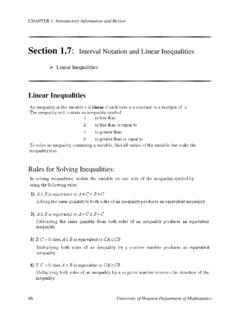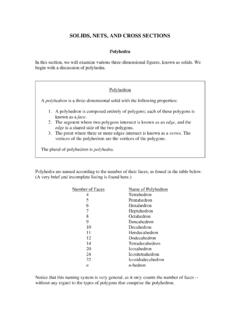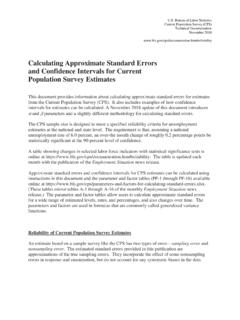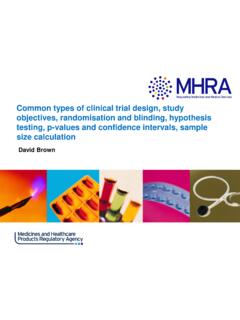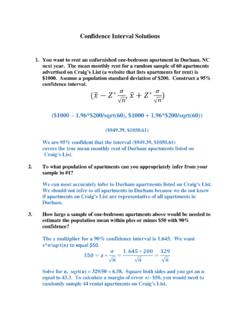Transcription of Probability and Statistics Vocabulary List (Definitions ...
1 Prob & Stat Vocab Probability and Statistics Vocabulary List (Definitions for Middle School Teachers) B Bar graph a diagram representing the frequency distribution for nominal or discrete data. It consists of a sequence of bars, or rectangles, corresponding to the possible values, and the length of each is proportional to the frequency. o For more info: Bayes formula Let 12,,..,nUUU be n mutually exclusive events whose union is the sample space S. Let E be an arbitrary event in S such that() 0PE . Then 1112()()()() .. ()nPUEPU EPUEPUEPUE = + + . Corresponding results hold for 23,,..,.nUUU o For more info: Binomial distribution the discrete Probability distribution for the number of successes when n independent experiments are carried out, each with the same Probability p of success. o For more info: Binomial theorem the formulae 22233 223()2()3 3xyxxy y and x yxx yxyy+=+ ++ =+ + + are used in elementary algebra. The Binomial theorem gives an expansion like this for ()nxy+, where n is any positive integer:12210121().
2 Nn nn nn nnn n nnnxyCxCxyCxyCxy Cy += + ++++. o For more info: Bins a term used to describe class intervals on a histogram. o For more info: Bivariate data Data involving two random variables, such as height and weight, or amount of smoking and measure of health; often graphed in a scatter plot. o For more info: Prob & Stat Vocab Box-and-whisker plot a diagram constructed from a set of numerical data showing a box that indicates the middle 50% of the marked observations together with lines, sometime called whiskers , that go out from the quartile to the most extreme data value in that direction which is not more than times the Inter Quartile Range from the quartile. o For more info: C Categorical data data that fits into a small number of discrete categories. Categorical data is either non-ordered (nominal) such as gender or city, or ordered (ordinal) such as high, medium, or low temperature. o For more info: Central limit theorem it pertains to the convergence in distribution of (normalized) sums of random variables.
3 The distribution of the mean of a sequence of random variables tends to a normal distribution as the number in the sequence increases indefinitely. The most general version of the states: Let 12,,..XXbe a sequence of independent, identically distributed random variables with mean and finite variance2 . Let1(),niinnnXnXXZn = == . Then as n increases indefinitely, the distribution of nZtends to the standard normal distribution. o For more info: Circle graph a graph for categorical data. The proportion of elements belonging to each category is proportionally represented as a pie-shaped sector of a circle. Sometimes called a pie chart. o For more info: Class intervals a subdivision within a range of values. In a histogram, the range of values is divided into sections, known as class intervals, also referred to as bins. o For more info: Clusters of data a portion of high concentration in a data set. o For more info: Prob & Stat Vocab Combination the number of ways of picking k unordered outcomes from n possibilities.
4 The number of combinations of n distinct objects taken r at a time is!(,)()!!nCnrnrr= . For example: The number of ways in which a committee of 2 people can be selected out of 4 people is4!(4, 2)6(4 2)!2!Cways== . Let these people be denoted as A, B, C, and D. Then the set of all possible combinations is {AB, AC, AD, BC, BD, CD}. Note that the choice AB is equivalent to BA, ordering doesn t matter. o For more info: Complement of an event suppose A is an event in the universal set U, the complement of A ("not A") consists of all the outcomes in U that are not in A. For example, if A is the event that two of three children are boys, then cA(complement of A) is the event that there are either zero, one, or three boys. o For more info: Compound events - an event made of two or more simple events. o For more info: Conditional Probability let A and B be two events. The Probability that A will occur given that B has already occurred is the conditional Probability of A given B and is denote by()PAB.
5 O For more info: confidence interval an interval, calculated from a sample, which contains the value of a certain population parameter with a specified Probability . confidence level - the Probability that the statistician's confidence interval contains the true, unknown population parameter. Correlation the correlation between two variables x and y is a measure of how closely related they are, or how linearly related they are. Correlation is the measure of the extent to which a change in one random variable tends to correspond to change in the other random variable. For example, height and weight have a moderately strong positive correlation. o For more info: Prob & Stat Vocab Correlation coefficients a measure of how close two random variables are to being perfectly linearly related; computed by dividing the covariance of the random variables by the product of their standard deviation. The correlation coefficient denoted by takes values between -1 and 1; -1 represents a perfect negative correlation while 1 represents a perfect positive correlation.
6 O For more info: Counting Principle a method used to compute the number of possible outcomes of an experiment. If each outcome has independent parts, the total number of possible outcomes can be found by multiplying the number of choices for each part. o For more info: Cumulative frequency the sum of the frequencies of all the values up to a given value. If the values12, ,..,nxxx, in ascending order, occur with frequencies 12,,..,nfff respectively, then the cumulative frequency at ++. o For more info: Cumulative relative frequency (relative cumulative frequency) o The cumulative frequency in a frequency distribution divided by the total number of data points. o For more info: D Data the observations gathered from an experiment, survey or observational study. o For more info: Density function a mathematical function used to determine probabilities for a continuous random variable. For example, the bell-shaped curve corresponding to a normal distribution.
7 O For more info: :density+function Prob & Stat Vocab Dependent event two events are dependent if the occurrence of either affects the Probability of the occurrence of the other. o For more info: Designed experiment the process of planning an experiment or evaluation so that appropriate data will be collected, which may be analyzed by statistical methods resulting in valid and objective conclusions. Examples include: complete random design, random design, and randomized block design. Deterministic experiment a process in which the outcome is known in advance. For example tossing a two headed coin. Disjoint sets are disjoint if they have no elements in common. For example, the sets A = {1,2,3} and B = {5,6,7} are disjoint. Dispersion a way of describing how scattered or spread out the observations in a sample are. Common measures of dispersion are the range, inter quartile range, variance, and standard deviation. Distribution the distribution of a random variable is the way in which the Probability of it taking a certain value, or a value within a certain interval is described.
8 It may be given by the cumulative distribution function, the Probability mass function (discrete random variable) or the Probability density function (continuous random variable). E Element an object in a set is an element of that set. Empirical Probability the Probability of an event determined by repeatedly performing an experiment. It may be determined by dividing the number of times the event occurred by the number of times the experiment was repeated. For more info: Equality (of sets) sets A and B are equal if they consist of the same elements. In order to establish A=B, a technique that can be useful is to show that each is contained in the other. Equally likely outcomes every outcome of an experiment has the same Probability . For example: rolling a fair die has equally likely outcomes. o For more info: Prob & Stat Vocab Event a subset of the sample space. For example, the sample space for an experiment in which a coin is tosses twice is given by {HH, HT, TH, TT} and let A= {HT, HH}, then A is an event in which Head occurs at the first place.
9 O For more info: Expected value it is the average value of a random quantity that has been repeatedly observed in replications of an experiment. For example, if a fair 6-sided die is rolled, its expected value is o For more info: Experiment processes in which there are an observable set of outcomes are called experiments. For example, the following are all experiments: tossing a coin, rolling a die, or selecting a ball from a bag. o For more info: Experimental Probability The estimated Probability of an event; obtained by dividing the number of successful trials by the total number of trials. F Fair coin a fair coin is defined as coin where the Probability of landing heads up or tails up are the same ( ). Fair game a game is fair if each player has an equal chance of winning. Finite sample space a sample space which contains a finite number of possible outcomes. Frequency the number of times that a particular value occurs as an observation.
10 O For more info: Frequency distribution the information consisting of the possible values/groups and the corresponding frequencies is called the frequency distribution. o For more info: Frequency table a table giving the number of data points in a data set falling in each of a set of given intervals. o For more info: G Prob & Stat Vocab Geometric distribution a discrete Probability distribution for the number of trials required to achieve the first success in a sequence of independent trials, all with the same Probability p of success. Its Probability mass function is given by1[](1)xPX xpp == . For example, the number of times one must toss a fair coin until the first time the coin lands heads has a geometric distribution with parameter p = 50%. Geometric Probability the Probability of an event as determined by comparing the areas (or perimeters, angle measures, etc.) of the regions of success of an event to the total area of the figure (sample space).
